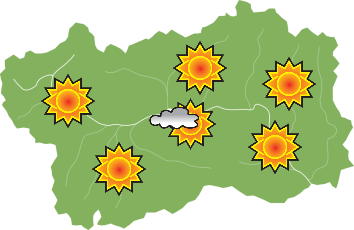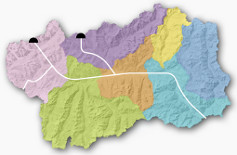Flavours and scents of the lower Aosta Valley
How: by car.
Recommended duration: one day.
Recommended period: all year round.
Distance: about 10 km.
To the Aosta Valley from Piedmont, the towns and villages to be discovered along the way are waiting to greet gourmets with pleasant surprises such as full bodied wines and a high quality ‘lardo DOP’.
Wines
The mountain is distinguished by the vineyards on the ‘adret’, the sunny side of the river, where the grapes gently bask in the sun from the early morning to sunset.
Reds: Arnad-Montjovet, Donnas, Gamay, Merlot, Nebbiolo, Pinot Noir, Syrah
Whites: Chardonnay, Müller Thurgau, Petite Arvine, Pinot Grigio
Rosés: Nebbiolo Rosato
Straw wines: Chardonnay Vendemmia Tardiva, Pinot Grigio Vendemmia Tardiva
Grappa
Grappa di Nebbiolo
Cured meats and sausages
The Lard d’Arnad, a product with Protected Designation of Origin (‘DOP’), is only produced from the shoulder of pigs which weigh more than 200 kg. The pieces of fat are placed to mature inside ‘doils’, old oak or chestnut wood containers inside of which the fat is layered until the top and the layers are alternated with a mixture made of salt, water, spices natural flavourings and aromatic mountain herbs. The ‘lardo’ is then left to age for at least three months; it is during this process that the product takes on the smell and the special organoleptic characteristics that set it apart. The thin slices of cured fat melt in the mouth: heavenly when combined with crusty rye bread, softened by a drop of honey.
The local producers also offer other traditional cured meats: the motzetta, flavour-packed, aromatic dried meat (beef or chamois goat meat) and the Boudins (pig blood sausages with potato and beetroot) to mention just a few.
Cheese
In addition to Fontina DOP cheese, which can be found all over the Aosta Valley region, the local farms also produce other fresh cow’s milk cheeses (such as reblec cheese) as well as matured cheeses (various toma cheeses) and other milk derivatives (brossa, butter, yoghurt). Also typical of the area is salignön, a creamy and fatty ricotta, with a spicy flavour mixed with salt, pepper and chilli.
The dairy farms can be visited upon reservation and the products can be bought from the various shops found on the premises.
Interesting facts
- In Bard the fort, an impenetrable barrier of the nineteenth century, is today a European centre of culture with museum and exhibition spaces, which is also used to host important events.
- The Micòoula is a sweet bread which is typical of the municipality of Hône made from whole meal flour of wheat and rye, chestnuts, raisins, dried figs, butter, egg, salt and sugar. Originally, the bread contained chestnuts from the Champorcher valley, already well-known in the middle ages.
- A delicious specialty of this area is also the piata of Issogne. In this hamlet, already famous for its magnificent castle of the noble Challant family (open to the public), this sweet focaccia was produced in the past for family consumption with rye flour, butter, raisins and nuts and decorated with apples and sugar glaze. Today it can be found on sale in grocery stores in the village.
- Influenced by the cuisine of nearby Piedmont, the miasse are a particular delicacy; once a substitute for bread, ‘miasse’ are a special type of flat bread made from water, corn flour, eggs and oil, cooked on special pans that are heated directly on the fire. The taste and outcome depends on the ability of the cook: the dough has to be spread onto the pan and then worked using special tools. An excellent accompaniment to cured meats and salignön.
Events
- Towards the end of August, in Arnad the Lardo Festival takes place which celebrates the high quality lardo DOP: in addition to tastings and various entertainments, the event offers fascinating taste workshops.
- The village of Donnas is enlivened by fantastic festivals throughout October: including the Grape Festival, where many producers of the area compete for the prize ‘Grappolo d'oro’ (golden bunch). There is also the Chestnut Festival that ends with a competition between the chestnut roasters for awarding the ‘golden chestnut’.
- In Bard, again in October, the Marché au Fort takes place, a food and wine market in the village at the foot of the Fort; it is a comprehensive showcase of all the food production of the Aosta Valley.
- At the beginning of December, the village of Hône celebrates the Aosta Valley forefather of the Italian panettone with the Micòoula Festival, during which there are demonstrations of kneading and cooking the typical bread as well as a traditional agri-food market.












